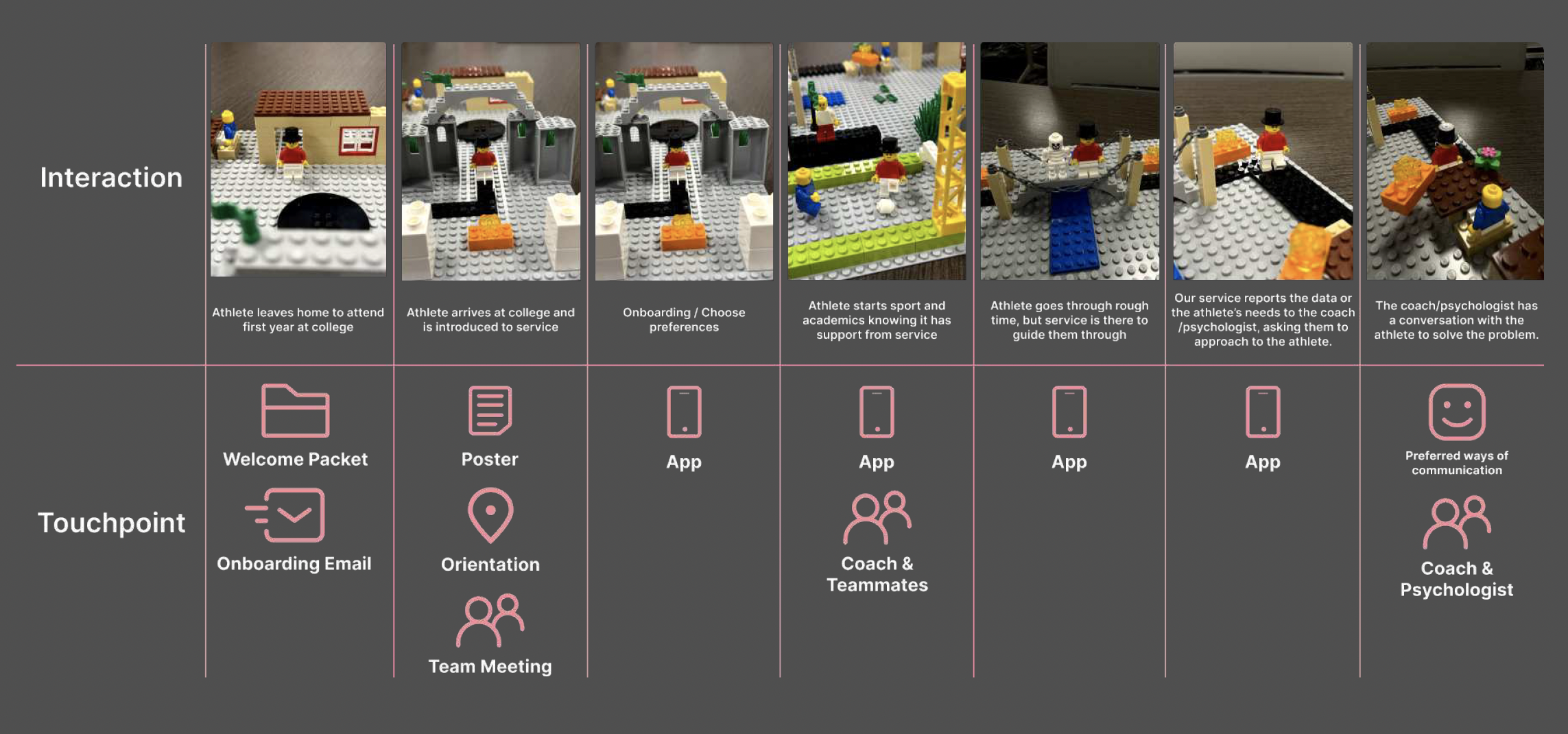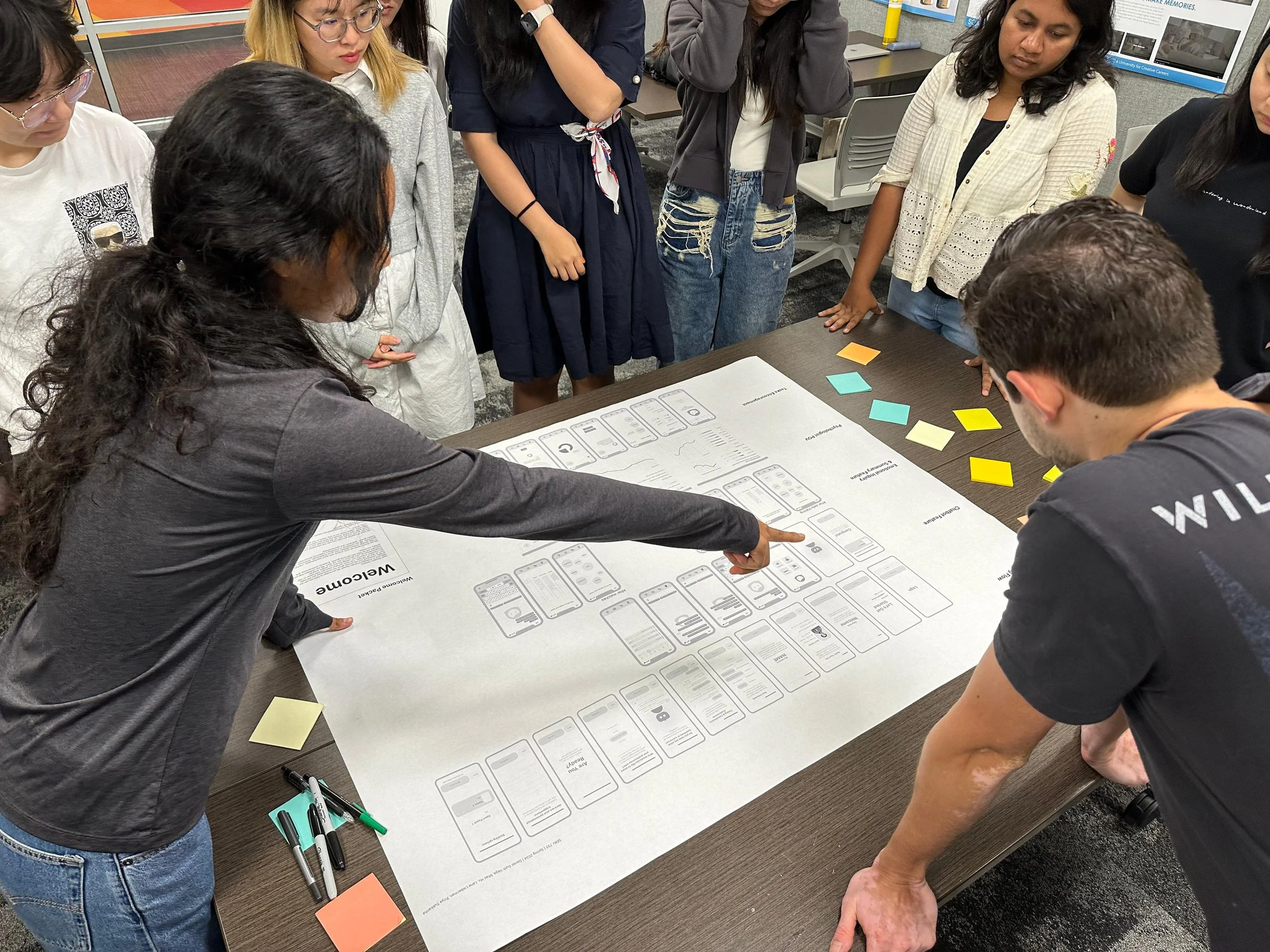Empowering college athletes through sport psychology
THE PROBLEM
College athletes face a uniquely high-pressure environment, juggling the demands of academic life, athletic performance, and personal well-being. Despite the availability of support resources, many struggle to access consistent, tailored guidance, especially during the critical transition into college. Many athletes struggle with issues such as performance anxiety, lack of motivation, and difficulty in maintaining focus during competitions, impacting their overall athletic performance and mental well-being. Gaps in communication between athletes, coaches, and mental health professionals often leave students without the support they need to thrive.
This project was developed using service design prototyping methods to explore the needs of student-athletes and the systems that support them. Through interviews, journey mapping, and co-creation sessions, we identified key pain points and tested service concepts to determine the most viable and impactful MVP. The result is a platform designed not only for performance, but for long-term well-being and successful transitions into and through college life.
THE OPPORTUNITY
There is an opportunity to design a holistic digital platform that supports college athletes by integrating mental health, performance coaching, and academic resources. By creating a shared space for athletes, sports psychologists, and coaches, we can foster stronger relationships, provide proactive support, and equip athletes with tools to navigate their college journey with confidence and balance.
THE PROCESS
Through primary research, we collected 48 survey responses from student-athletes across U.S. universities—and unsurprisingly, 100% reported experiencing stress related to their sport.
This finding highlights a clear and urgent need for more comprehensive support systems. In parallel, secondary research reinforces that existing support staff often face limitations in capacity and resources, leaving many student-athletes underserved in areas critical to their well-being and performance
The Current Reality
We developed a user journey map to understand the current experience of college athletes. The goal was to visualize their day-to-day realities, highlight emotional highs and lows, and identify critical pain points and unmet needs across their academic, athletic, and personal lives. By mapping key moments, we gained a holistic view of where support breaks down and where intervention could create meaningful impact.
Two Key Moments:
1. When the student first faces a struggle (e.g., pressure to perform, trouble adapting, balancing academics, trouble in team dynamics)
2. When student's are aware of the resources but don’t follow through.
Envisioning the Future Service
We used a desktop walkthrough to prototype the future-state service experience for student-athletes. This method allowed us to simulate real scenarios and interactions, helping us better understand how and when the service should be introduced. We envisioned the service being presented preemptively—before the athlete reaches a breaking point—to proactively reduce feelings of isolation and stress.
By walking through the athlete’s journey using physical and digital artifacts, we were able to ask key questions:
What does the first point of contact look like?
How can we make the service feel personal and approachable?
What touchpoints are most critical in building trust and relevance?
Key Interaction and Touchpoint
Following our desktop walkthrough, we created a service map to define key touchpoints and interactions throughout the athlete’s journey.
One of the most critical moments we identified was onboarding, which we planned to introduce even before the athlete arrives on campus. By making onboarding a required part of all freshman athletes’ orientation, the service becomes a natural and expected part of their transition, not an optional add-on.
Our goal was to embed the service seamlessly into the athlete’s routine. Rather than feeling like an external resource, it should function as a supportive tool that grows with them, fostering familiarity, building trust, and making mental health support and performance tools accessible when they need it most.
CONVERSATIONAL PROTOTYPING
This flowchart outlines the onboarding process. We used this approach to define our onboarding user flow. We involved classmates in this conversational prototyping to ensure the onboarding process is smooth, informative, and friendly. Through research and prototyping, we recognized that early engagement was crucial for building trust and encouraging long-term use. One of our core values is to act as a friend along the journey, utilizing the AI chatbot to actively engage with users.
USER TESTING
We developed mid-fidelity wireframes to test key features of our service from both the student-athlete and sport psychologist perspectives.
Our goal was to validate core service interactions, strengthen the human-bot relationship, and ensure a supportive, intuitive experience across user types. We refined the app’s flow and usability by detailing each feature, focusing on how users would move through the platform in real scenarios.
A central feature we tested was the "Emotion Check-In," which allows athletes to log their mood and stress levels regularly. From the psychologist’s view, this feature surfaces important emotional trends, helping them proactively offer the right support and interventions to keep athletes active, healthy, and mentally resilient.
Mid-fidelity wireframes illustrating the core user flows for both student-athletes, focusing on the emotion check-in feature and early service interactions.
Final Concept
Steady aims to bridge the relationships and resources between student-athletes, coaches, and sports psychologists, making their transition into college smoother and setting them up to use these resources whenever they need them in the future.
Onboarding Experience
Introduced before arrival, onboarding is required for all freshman athletes and designed to be simple and supportive
Pre-Populated Fields
Basic information is auto-filled to reduce friction and make first steps easy.
Personalized Experience
Content, routines, and resources are tailored based on the athlete’s inputs and emotional check-ins.
Privacy First
Athletes control their data, with full transparency on how information is used to foster trust and safety.
At the center is "Teddy," a chatbot designed to act as a trusted friend—guiding athletes, offering quick help, and encouraging healthy routines.
Proactively address user needs
Steady proactively supports student-athletes by encouraging them to set up weekly check-ins and routines.
By focusing on preventative features, the platform reaches users before they hit a breaking point (The Bridge), building familiarity and trust early on. This approach helps athletes feel more comfortable seeking help when real challenges arise.
Emotion Check-In, prompted by Teddy.
This gentle nudge encourages athletes to reflect on their emotional state, creating a habit of self-awareness and emotional tracking. While our current concept includes a once-a-day check-in, further development would involve testing different frequencies, such as multiple times per day or user-defined schedules to understand what feels most natural and sustainable. We would also explore motivational strategies, like habit streaks, encouraging messages, or personalized insights, to help make emotional check-ins a consistent and valued part of the user’s routine.
A Space to Reflect
Steady’s profile page surfaces personal trends and progress based on emotional check-ins and activity data. This visual feedback encourages self-awareness, motivates continued engagement, and helps student-athletes build healthy, consistent habits over time.
“Seeing my stress levels go down over the week actually made me feel proud, like I’m really managing things better.”
“It’s nice to have a space that reminds me to slow down and check in with myself.”
KET TAKEAWAYS
Personal Connection — As a student-athlete myself (along with one teammate), this project felt especially meaningful. We could deeply relate to the struggles uncovered through research and reflected on our own experiences at every stage of the process.
Designing Through Prototyping — Using various service design prototyping methods like desktop walkthroughs and conversation prototyping allowed us to visualize the service from multiple perspectives. These techniques made invisible moments tangible and helped us co-create solutions with our users.
Interdisciplinary Collaboration — This project taught me how to collaborate across disciplines and design beyond the screen. Combining UX, service strategy, and emotional design challenged me to think holistically and design a service that supports real people, not just a user interface.
















